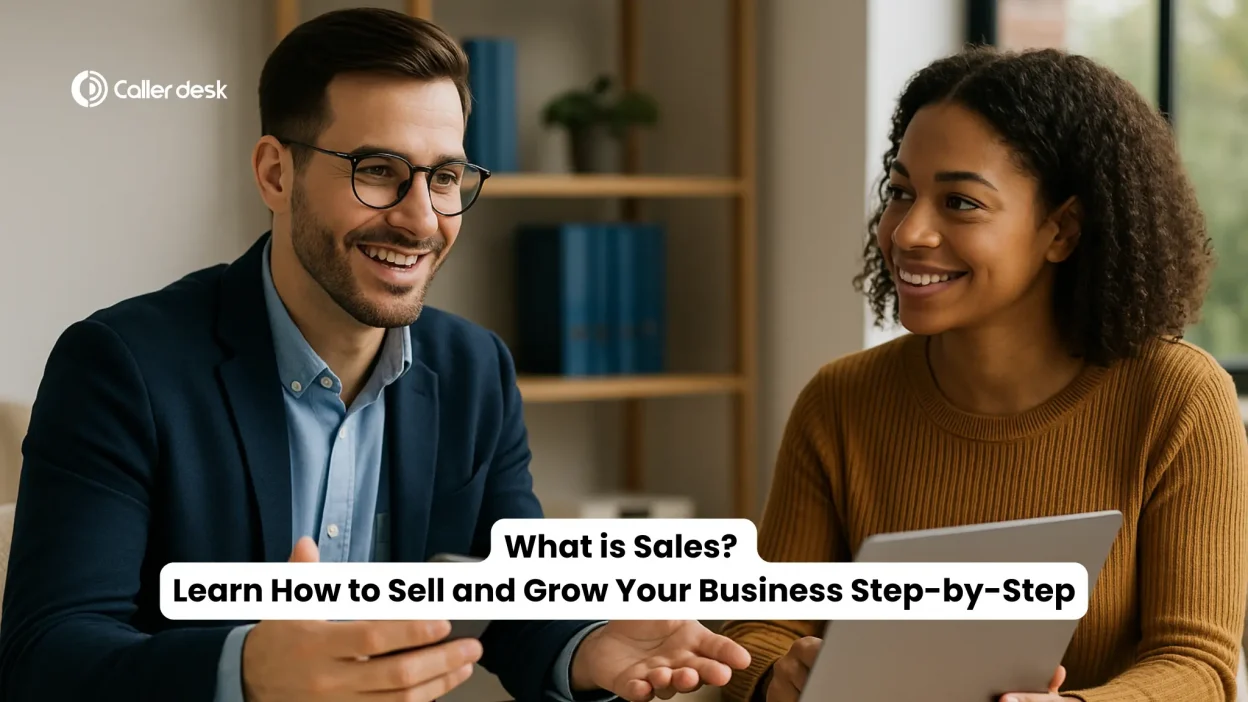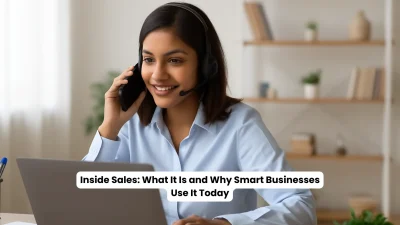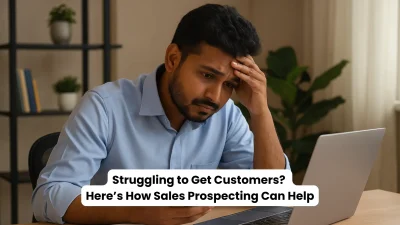Most people think sales means talking fast or forcing someone to buy something.
But that’s not true.
Sales is simply helping someone who has a problem – and showing them how your product or service can solve it.
Think about it:
If someone needs a good phone, and you help them pick the right one, you’ve made a sale.
If a business needs software to manage calls, and you explain how yours helps – that’s also sales.
You don’t need to be clever, loud, or pushy.
You just need to understand what people need and explain how you can help – clearly, honestly, and at the right time.
Once you understand this, sales becomes easy, natural, and even fun.
Let’s break it down in the simplest way possible – so anyone can learn how to sell with confidence.
What is Sales?
Sales means helping people by giving them a product or service that solves their problem – and in return, you earn money.
But it’s not only about money.
Sales is also about:
- Understanding what people need
- Giving them the right solution
- Building trust so they feel confident buying from you
- Creating long-term relationships, not just one-time deals
Think of it like this:
If you don’t make any sales, you don’t have a real business – you just have a costly hobby.
Sales is what keeps every business alive and growing.
Why Do People Feel Nervous About Sales?
Many people feel nervous about sales because they think it’s too hard or not meant for them. Here’s why that happens:
- They aren’t sure how to begin.
- They think selling means forcing someone to buy.
- They’re scared of hearing “no” from customers.
But the truth is, sales isn’t something you’re born with – it’s something you can learn. It’s just like learning to ride a bicycle. You might fall at first, but with the right steps and some practice, you’ll get better.
Good salespeople don’t try to pressure others. Instead, they focus on understanding the problem and offering the right solution.
Sales becomes easier when you stop trying to “convince” and start trying to help. That shift makes all the difference.
Different Types of Sales (Explained Simply)
Not all sales work the same way. Depending on what you’re selling and who you’re selling to, the sales process can be very different. Let’s break down the most common types of sales in simple words:
1. Inbound Sales
In inbound sales, the customer comes to you first.
They may have seen your ad, read your blog, or watched a video about your product.
Once they show interest, your job is to guide them and help them make the right decision.
Example: A person visits your website, signs up for a free trial, and you follow up to help them.
2. Outbound Sales
Here, you make the first move.
You reach out to potential customers through phone calls, emails, or messages – even if they’ve never heard of you before.
Example: You find a business that might need your product, and you call or email them to explain how you can help.
3. B2B Sales (Business-to-Business)
This type of sales happens when one business sells products or services to another business.
It usually involves bigger deals, more discussions, and a longer process.
Example: A software company sells a project management tool to a marketing agency.
4. B2C Sales (Business-to-Consumer)
In B2C sales, you sell directly to individuals for personal use.
The buying decision is usually faster and simpler.
Example: Selling mobile phones, clothes, or online subscriptions to individual customers.
5. Inside Sales
In inside sales, the salesperson does not meet the customer face-to-face.
Instead, they sell using phone calls, emails, or video meetings – all from their office or home.
Everything happens remotely, and there’s no need to travel.
Example: A sales agent sits at a desk, calls a customer, explains the product on a video call, and closes the deal – without ever meeting the person in real life.
6. Outside Sales
This is also called field sales.
You meet customers face-to-face, usually by visiting their offices or attending events.
Example: A sales rep travels to different cities to meet clients and give live product demos.
7. SaaS Sales (Software as a Service)
You sell software that people pay for every month or year instead of buying it once.
These tools usually work online and help businesses with specific tasks.
Example: Selling a cloud-based accounting app to small businesses on a subscription plan.
8. Enterprise Sales
This is selling to big companies.
These deals take longer because more people are involved in the decision.
But the contracts are large, and the rewards are high.
Example: A telecom company selling custom solutions to a national bank.
9. Small Business Sales
This involves selling to small or medium-sized businesses like local shops, startups, or service companies.
The process is faster and more personal, with fewer people involved in the decision.
Example: Selling marketing software to a 5-person digital agency.
Sales Process: How to Turn a Lead into a Paying Customer
A sales process is a step-by-step method that helps you move a person from “just thinking” to “yes, I’ll buy.”
It gives your team a clear roadmap to follow so you don’t waste time or lose good leads. Let’s break it down in easy steps:
Step 1: Prospecting
This is where everything begins. You search for people or businesses who might need what you’re offering. You can find them through social media, cold calls, networking events, referrals, or email lists.
The goal here is simple: identify potential customers.
Step 2: Qualifying
Not everyone you find will be the right customer. In this step, you ask a few questions to check:
- Do they have a real need?
- Can they afford it?
- Are they the person who can make the final decision?
This helps you focus only on serious buyers and save time.
Step 3: Presenting Your Offer
Now that you know they’re a good fit, it’s time to show them how your product or service can solve their problem.
You can do this through:
- A product demo
- A quick pitch
- A live call or meeting
Make sure you use simple words and real-life examples so they understand how it will help them.
Step 4: Handling Objections
Most people have questions before they buy. They might ask:
- Is this too expensive?
- How long will it take?
- What if it doesn’t work for me?
Instead of avoiding these questions, answer them honestly. This builds trust and removes the roadblocks to closing the deal.
Step 5: Closing the Deal
Once all doubts are cleared, it’s time to move things forward. Ask them clearly:
- “Are you ready to go ahead?”
- “Can we start the paperwork?”
- “Should I send you the contract?”
If they say yes, that’s a closed deal.
Step 6: Follow Up
Your job doesn’t end after the sale. Follow up to:
- Check if they’re happy
- Solve any issues
- Ask for feedback or a referral
Happy customers often come back again – or send new leads your way.
10 Sales Tips to Close Deals Faster
1. Listen First, Then Speak
Don’t start with a sales pitch. Begin by asking questions and listening carefully to the customer. Understand what problem they are facing before offering your solution. When people feel heard, they trust you more.
2. Know Your Product Completely
You should be able to explain your product or service clearly, confidently, and in your own words. The better you know what you’re selling, the easier it becomes to answer questions and build trust with the customer.
3. Speak in Simple Language
Avoid using technical words or difficult terms. Talk in a way that anyone can understand. Your customer should feel like you’re guiding them, not confusing them.
4. Create a Sense of Urgency
Sometimes people delay making a decision. You can speed things up by offering a limited-time discount or bonus. For example, “If you buy today, you’ll get 10% off.”
5. Follow Up with Value
If a customer says they’ll “think about it,” don’t just call to ask, “Have you decided?” Instead, follow up with helpful information—like a case study, demo video, or answers to their earlier questions.
6. Show Proof with Testimonials
People trust what others say more than what you say. Share stories or reviews from happy customers who have already used your product. This builds trust and shows that your solution works.
7. Ask for the Sale Clearly
Don’t wait too long or beat around the bush. Once you’ve explained everything and the customer is ready, ask politely if they’d like to move forward. Being direct shows confidence.
8. Offer Flexible Payment Options
Sometimes people like your product but can’t pay all at once. You can make it easier for them by offering installment plans, discounts on full payments, or different payment methods.
9. Talk About the Real Benefit
Instead of only listing features, explain how your product will help the customer. Will it save them time? Help them earn more money? Make their life easier? Focus on that.
10. Know When to Stop
Not everyone you talk to will buy. And that’s okay. If someone clearly isn’t interested or doesn’t need your solution, don’t waste too much time. Move on to the next person who might be a better fit.
Conclusion
Sales isn’t about pressure.
It’s not about pushing people to say “yes.”
It’s about listening, understanding, and offering the right solution at the right time.
Whether you’re selling to a person or a business, online or offline, big company or small shop – the basics remain the same:
- Know what the customer needs
- Show how you can help
- Build trust step-by-step
- Follow a simple, repeatable process
And remember: You don’t need to be a smooth talker to succeed in sales. You just need to care, communicate clearly, and stay consistent.
The more you practice, the easier it gets.
If you’re ready to sell smarter – not harder – start building your sales process today.
Want a Smarter Way to Manage Sales Calls?
CallerDesk is India’s leading cloud telephony platform – built to help you handle calls better, faster, and smarter.
From smart IVR and real-time tracking to auto-dialers and CRM integration, it’s everything your sales or support team needs – all in one place.
Visit CallerDesk.io to get started today.



